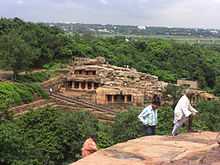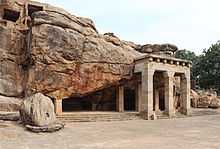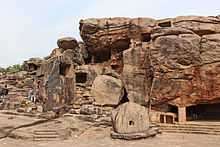Udayagiri and Khandagiri Caves
Coordinates: 20°15′46″N 85°47′10″E / 20.2628312°N 85.7860297°E






| Part of a series on |
| Jainism |
|---|
 |
|
Jain Prayers |
|
Major figures |
|
Major Sects |
|
Festivals |
| Jainism portal |
Udayagiri and Khandagiri Caves (Oriya: ଉଦୟଗିରି ଓ ଖଣ୍ଡଗିରି ଗୁମ୍ଫା) are partly natural and partly artificial caves of archaeological, historical and religious importance near the city of Bhubaneswar in Odisha, India. The caves are situated on two adjacent hills, Udayagiri and Khandagiri, mentioned as Kumari Parvat in the Hathigumpha inscription. They have a number of finely and ornately carved caves. It is believed that most of these caves were carved out as residential blocks for Jain monks during the reign of King Kharavela. Udayagiri means "Sunrise Hill" and has 18 caves while Khandagiri has 15 caves.
The caves of Udayagiri and Khandagiri, called lena or leṇa in the inscriptions, were dug out mostly during the reign of Kharavela for the abode of Jaina ascetics. The most important of this group is Ranigumpha in Udayagiri which is a double storeyed monastery.
Count of the caves
B.M. Barua, based on a reading of line 14 of the Hathigumpha inscription, declared that a total of 117 caves were excavated by Kharavela and others on the Kumari hill (Udayagiri). Marshall has counted more than 35 caves in both the hills, while M.M. Ganguli has enumerated only 27 caves.
The number of existing caves at Udayagiri is 18, while Khandagiri has 15. The local names of the existing caves are listed below, numbered according to the enumeration of the Archaeological Survey of India.
The famous caves
In Udayagiri, Hathigumpha (cave 14) and Ganeshagumpha (cave 10) are especially well known due to art treasures of their sculptures and reliefs as well as due to their historical importance. Rani ka Naur (Queen's Palace cave, cave 1) is also an extensively carved cave and elaborately embellished with sculptural friezes. Khandagiri offers a fine view back over Bhubaneswar from its summit. The Ananta cave (cave 3) depicts carved figures of women, elephants, athletes, and geese carrying flowers.
Inscriptions in Caves in Brahmi
Hathigumpha inscription

The Hathigumpha cave ("Elephant Cave") has the Hathigumpha inscription, written by Raja Kharavela, the king of Kalinga in India, during the 2nd century BCE. The Hathigumpha inscription consists of seventeen lines incised in deep cut Brahmi letters on the overhanging brow of a natural cavern Hathigumpha in the south side of the Udayagiri hill. It faces the rock edicts of Asoka at Dhauli, situated about six miles away.
Other minor inscriptions
Besides Hathigumpha Inscription of Kharavela, there are some other minor Brahmi inscriptions in the twin hillocks of Udayagiri and Khandagiri, which were deciphered earlier by Prof RD Banergy during 1915-16 (Epigraphic Indica-XIII) and BM Baraua (Indian Historical Quarterly-XIV). Sadananda Agrawal has given further clarifications about them and are produced as under:
I- Mancapuri cave inscription (Upper storey)
This inscription is engraved on the raised space between the second and third doorways of the cave. The text in Devanagari script is as under:
L.1- अरहंत पसादाय कलिंगानं समनानं लेनं कारितं राजिनो ललाकस
L.2- हथिसिहस पपोतस धुतुना कलिंग चकवतिनो सिरिखारवेलस
L.3- अगमहिसिना कारितं
Translation - By the blessings of Arhats, the chief queen of Kharavela, the Cakravarti monarch of Kalinga, the great granddaughter of Hathisiha (Hasti Simha) and the daughter of Lalāka or Lalārka caused to be excavated the cave for the sramanas of Kalinga.
II- Mancapuri cave inscription (Upper storey)-A
This inscription is incised on a raised bend between the 3rd and 4th doorways from the left and contains single line. The text in Devanagari script is as under:
ऐरस महाराजस कलिंगाधिपतिना महामेघवाहनस कुदेपसिरिनो लेणं
Translation - This is the cave of Aira Mahameghavahana Maharaja Kudepasiri, the overlord of Kalinga.
Note:- Kudepasiri seems to be the immediate successor of Kharavela.
III-Manchapuri cave inscription 'B' (Lower storey)
This inscription has been engraved on the right wall of Veranda, to the right of the entrance to the right-hand side chamber of the main wing, consisting of one line. The text in Devanagari script is as under:
कुमारो वडुखस लेणं
Translation - [This is] the cave of Prince Vaḍukha.
Note:- On palaeographic ground Prof Banergy considers this inscription to be a little earlier than the inscription of King Kudepasiri. According to Sadananda Agrawal, Prince Badukha stands an obscure figure in history, but Badukha seems to be the son or brother of Kudepasiri.
IV- Inscriptions in the Sarpagumpha (Over the door way)
This inscription consisting of one line, is incised over the doorway of the Sarpagumpha. The text in Devanagari script is as under:
चूलकमस कोठाजेया च
Translation - The chamber and veranda/or side chamber of cūlakama. Note:- However Dr. Sahu interpreted Ajeya being united by a Sandhi qualifying Koṭha there by denoting invincible. But he ignored the conjunction ca (Devanagari: च) which follows Koṭha(Devanagari:कोठा) and Jeya (Devanagari:जेया).
V- Inscription in the Sarpagumpha ( to the left of the doorway) The text in Devanagari script is as under:
L.1- कंमस हलखि
L.2- णय च पसादो
Translation :- [The pavilion is the] gift of Kamma and Halakhina.
Note:- Most probably Halakhiṇa was the wife of Kamma. Chūlakamma - found in the inscription No.IV and Kamma of this record indicate official designations rather than the proper names. Kamma may be taken as minister of works (Karma saciva) and Cūlakamma appears to be a junior cadre of minister in the Department of works.
VI- Haridas cave inscription
This inscription contains one line has been incised over one of the three entrances to the main chamber of the cave from the veranda. The text in Devanagari script is as under:
चूलकमस पसातो कोठाजेया च
Translation :- The chamber and veranda (or side chamber) are the gift of cūlakama.
VII- Vyāghragumphā inscription
The record is incised on the outer wall of the inner chamber. The text in Devanagari script is as under:
L.1- नगर अखंदस
L.2- स भूतिनो लेणं
Translation :- The cave of Bhūti, the city judge.
VIII- Jambesavara cave inscription
This inscription has been engraved over the entrances to the inner chamber of the cave. The text in Devanagari script is as under:
महादस बरयाय नकियस लेनं
Translation :- The cave of Mahamāda Nākiya and Bāriyā.
X- Tatowāgumphā inscription (Cave No -1)
The record of this inscription is incised over one of the entrances to the inner chamber. The Text reads in Sanskrit as
पादमुलिकस कुसुमस लेणं x [॥]
Translation: The cave of Kusuma, the padamulika.
Notes:- There is a syllable after the word lenam, which may be read as ni or phi,. padamulika literally means, one who serves at the feet [of king].
According to Kishori Lal Faujdar, Here Kusuma seems to be related with Kaswan clan of Jats. He refers an article ‘Hathi Gumpha and three other inscriptions’ (page 24) in Devanagari as under:[1]
कुसवानाम् क्षत्रियानां च सहाय्यतावतां प्राप्त मसिक नगरम्
Kusawānāṃ kshatriyānāṃ ca Sahāyyatāvatāṃ prāpt masika nagaraṃ.
Translation:- This translates that the city of 'Masikanagara ' was obtained with the help of 'Kuswan' Kshatriyas.
Note:- Sadananda Agrawal has interpreted Masikanagara as Asikanagara and identified with the city Adam (Nagpur district). In view of the evidence of a highly prosperous city unearthed at Adam, Prof AM Shastri is of the opinion that Adam itself represents the Asikanagara of Hathigumpha inscription. It is worth noting in the present context that a terracotta sealing having a legend, has been discovered from Adam,[2] situated on the right bank of the river Wainganga, which reads Asakajanapadasa (Devanagari: असकजनपदस).
XI- Ananta Gumpha inscription (A)
The record is incised on the architrave between the left ante and the fifth pillar. The text in Oriya script is: Oriya: ଦୋହଦ ସମଣନ ଲେଖ (Devanagari: दोहद समणनं लेणं
Translation :- The cave of the Dohada Śramaṇas.
List of Caves at Udayagiri


- Ranigumpha
- Bajagharagumpha
- Chota Hathigumpha
- Alkapurigumpha
- Jaya-vijayagumpha
- Panasagumpha
- Thakuranigumpha
- Patalapurigumpha
- Mancapurigumpha
- Ganesagumpha
- Jambesvaragumpha
- Vyaghragumpha
- Sarpagumpha
- Hathigumpha
- Dhanagharagumpha
- Haridasagumpha
- Jagammathgumpha
- Rosaigumpha
List of Caves at Khandagiri

- Tatowa gumpha No.-1
- Tatowa gumpha No.-2
- Ananta gumpha
- Tentuli gumpha
- Khandagiri gumpha
- Dhyana gumpha
- Navamuni gumpha
- Barabhuji gumpha
- Trusula gumpha
- Ambika gumpha
- Lalatendukesari gumpha
- Unnamed
- Unnamed
- Ekadasi gumpha
- Unnamed
The above nomenclature has no historical significance but is accepted at present for the convenience of scholars and general readers. The art of Udayagiri and Khandagiri, being almost contemporaneous with that of Sanchi, has a striking resemblance to it but at the same time retains its own individuality and advanced technique.
Tickets
Entry fee for Citizens of India and visitors of SAARC (Bangladesh, Nepal, Bhutan, Sri Lanka, Pakistan, Maldives and Afghanistan) and BIMSTEC Countries (Bangladesh, Nepal, Bhutan, Sri Lanka, Thailand and Myanmar) - Rs. 5 per head and for each foreigner is Rs. 100.00 or US $2.00 and free entry for children below 15 years.
Timing
The monument remains open from sunrise to sunset.
See also
References
- Sachin Singhal: Orissa tourist road guide and political, Vardhman Publications, ISBN 81-8080-011-3
- Sadananda Agrawal: Sri Kharavela, Published by Sri Digambar Jain Samaj, Cuttack, 2000.
External links
| Wikimedia Commons has media related to Udayagiri and Khandagiri Caves. |
- http://www.indiaplaces.com/india-monuments/bhubaneshwar-udaigiri-caves.html
- Udayagiri Complex, extensive image gallery by Indira Gandhi National Centre of Arts
- Udayagiri Caves, Khandagiri Caves, Orissa - rock cut Jain temples by Wondermondo
- Detailed Photos of the Cave Temples
| ||||||||||||||||||||||||||||||||||||||||||||||||||||||||||||||||||